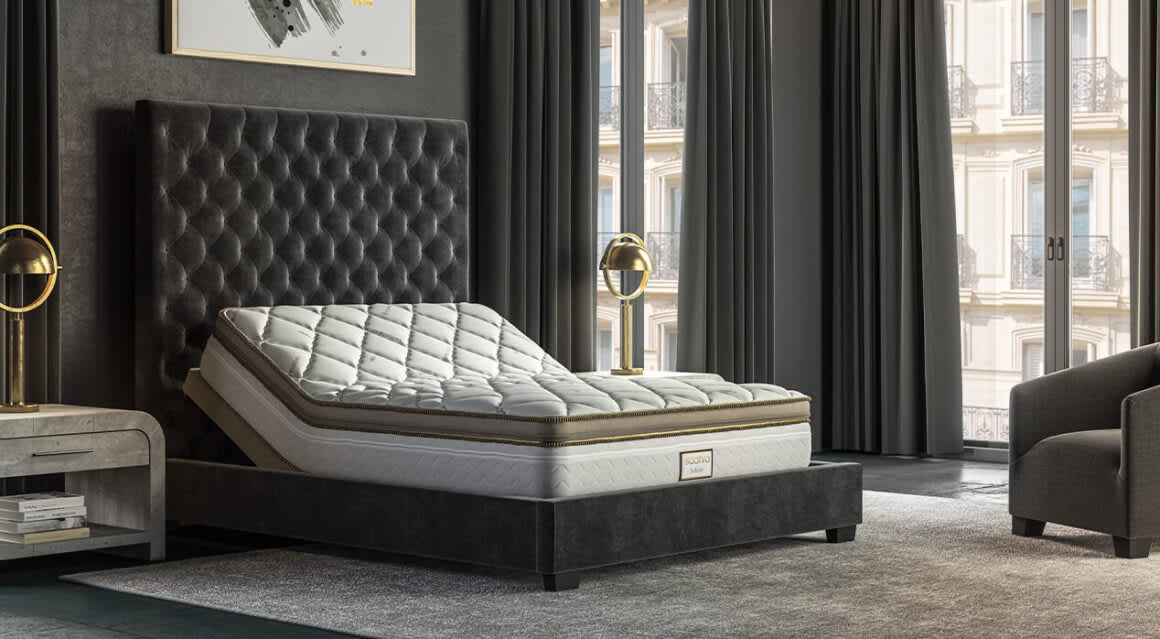On This Page
The Best Airbed Mattress of 2025
Our Top Picks
-
Best Overall Mattress
Solaire -
Best Value Airbed
Night Air Adjustable Airbed
Best Overall Mattress

The adjustable Solaire airbed epitomizes the luxurious construction and strong performance that have come to define the Saatva brand. You can choose from 50 different firmness levels, and memory foam and latex layers cushion and contour to your body for excellent pressure relief.
Pros & Cons
Pros
- Euro-top design with latex and gel-infused memory foam provides balanced pressure relief
- Excellent temperature neutrality
- Compatible with an adjustable base and available in split king and split California king sizes for full customization on each side
Cons
- High price-point and $99 processing fee for returns may be barriers for some shoppers
- Not available in twin size
Ratings
Our Take
Best Value Airbed

The Night Air Adjustable Airbed offers customizable comfort at a sticker price that falls well below average for this type of mattress. You can adjust the mattress to 100 different settings, and choose from two-chamber or six-chamber designs depending on your personal needs.
Pros & Cons
Pros
- Air chambers can be adjusted to 100 unique firmness levels
- Foam layers provide additional cushioning and pressure relief
- Center third of the bed has its own air chamber for targeted lumbar support
Cons
- Accessible pricing for an airbed but still expensive compared to other types of mattresses
- Limited sizes available
Ratings
Our Take
Compare Our Top Picks
| Mattress | Mattress Type | Ideal For | Value | Sleep Trial |
| Solaire | Airbed | Couples | Good Value | 365 Nights ($99 Return Fee) |
| Night Air Adjustable Airbed | Airbed | Combination Sleepers | Great Value | 100 nights |
Airbeds are the most flexible models on the market when it comes to firmness. They’re a great choice if you’re not sure what firmness is right for you, you want more control over how your bed feels, or you share the bed with someone who likes a different feel. Couples often love airbeds because it means they don’t have to compromise when hunting for a mattress. The major downside for these beds is typically price – in exchange for the control they give you, airbeds cost more than most other mattress types.
What Is an Airbed?
In contrast to coil-based or all-foam beds, an airbed features air chambers in its core that can be gradually inflated or deflated to adjust the firmness level of the mattress. The chambers are usually made of durable rubber with an air pump that is controlled by buttons, a remote control, or a smartphone app.
Airbeds offer the most firmness adjustability of any kind of mattress. Additionally, to enhance comfort and pressure relief, airbeds often include layers of memory foam, polyfoam, or latex. Some airbeds may also have coils or other design elements to improve edge support or overall stability.
Airbed vs. Inflatable Air Mattress
Airbeds are designed for everyday use, while inflatable air mattresses are only meant for short-term use, such as when traveling, camping, or hosting a guest.
Airbeds are far more robust, with thicker air chambers and complementary materials in other layers. Because they are only made for temporary use, inflatable air mattresses are made with thinner rubber and few or no additional materials, enabling them to be easily deflated and stored away.
Due to these differences in construction, airbeds cost significantly more than inflatable mattresses. Airbeds typically cost several thousand dollars, while inflatable air mattresses can be found for around $100.
Who Is a Good Match for an Airbed?
Airbeds are a great match for people who place a premium on the ability to adjust the firmness of their mattress. This includes combination sleepers who frequently shift between sleeping positions, people with chronic pain or those recovering from an injury, or anyone who isn’t sure about their preferred firmness level and wants the flexibility to modify the feel of their mattress on the fly.
Because the air chambers resist heat buildup, many airbeds are well-suited to hot sleepers. That said, airbeds with thick comfort layers may trap heat on a similar level to similarly constructed hybrid mattresses.
Couples often love airbeds since most models have distinct air chambers for each side of the bed, allowing each person to set their own firmness preferences.
Airbeds are usually not a good fit for budget shoppers since they are the most expensive type of mattress.
The performance of an airbed can vary based on its comfort layers. Pressure relief, responsiveness, and edge support may vary depending on the materials used in the comfort layers.
Pros
- Real-time firmness adjustments with the press of a button
- Dual-sided customizability for people who share a bed
- Air chambers resist heat retention
Cons
- High-end price-point may be outside the budget of many shoppers
- May lack bounce, edge support, or pressure relief depending on comfort layers
What You Need to Know Before Buying an Airbed
Airbeds are a unique type of mattress. Before making a purchase, it’s helpful to know how their atypical construction impacts their feel and how the firmness adjustments work. You may also want to look into practical factors such as pricing, assembly, and durability.
How Does It Feel?
The feel of an airbed depends on the firmness setting you choose. Most airbeds offer a range from soft (3) to firm (7), which you can adjust at any time.
The firmness can usually be set separately for each side of the mattress, enabling a different experience for each sleeper.
Apart from the support and firmness provided by the air chambers, the feel of an airbed is largely determined by its comfort layers. Some models have contouring foams that hug the body, while others may use bouncier materials such as coils or latex.
Adjusting the Firmness
A major selling point of an airbed is the modifiable firmness level. Making adjustments from soft to firm is easy with built-in buttons, a remote, or a branded smartphone app.
The right firmness level for you depends on your sleeping position, body weight, and personal preference. If you are a side sleeper or weigh less than 130 pounds, you may want to use a softer setting. If you sleep on your back or stomach or weigh over 230 pounds, a firmer setting provides more support.
You can modify the firmness as necessary during the night. You may also need to make small tweaks to the firmness setting if there are significant changes to your bedroom temperature or the atmospheric pressure, which can affect the inflation of the air chambers.
Pricing
Airbeds are the most expensive type of mattress, with an average price range between $1,500 and $5,000. The higher cost is due to the machinery required to inflate and deflate the air chambers. Mattress size, quality of materials, special features, and composition of the comfort layers may also affect the end price. You can expect to pay more for an airbed with zoned air chambers, thick comfort sections, or other additions. Costs for shipping and installation can also raise the price, since airbeds can’t be compressed like other types of mattresses.
Assembly
Because they have a more complex construction, including a built-in air pump, airbeds require more assembly than other types of mattresses. Whereas standard mattresses are often compressed for shipping and require the user to set them up, airbed manufacturers may include White Glove delivery in the purchase price, meaning a team will come to your home and set up the mattress for you.
Durability
Airbeds are well-regarded for their durability and can be expected to last for eight years or longer. This is equal to or longer than most traditional mattress types.
As with any mattress, an airbed’s lifespan depends on how it is maintained. You can lengthen your bed’s lifespan by cleaning and regularly rotating it according to the manufacturer’s instructions. A waterproof mattress protector may also be helpful to protect against spills that may damage the internal components.
One benefit to an airbed is that even if a component malfunctions, it can usually be easily replaced to get the bed up and running again. Before buying, it’s a good idea to check the warranty to see if these replacements are covered.
Special Features
Airbeds often incorporate technological features to enhance the sleep experience. When shopping for an airbed, you should consider whether any special features are particularly valuable to you. Examples include:
- Wireless remotes or app-based controls
- Compatibility with an adjustable bed frame
- Built-in sensors that track movement and provide data about your sleep
- Heating or cooling elements
- Memory options for your favorite firmness settings
- Zoned air chambers
Video: How to Choose a Mattress
Watch our video to learn more about what to consider in the right mattress for your needs. Whether you’re a side sleeper, back sleeper, or stomach sleeper, whether you have aches and pains, allergies, or just want to upgrade your sleep experience, this mattress buying guide has got you covered.
Discover More Mattress Solutions
Take a deep dive into other great mattress options with our tailored buying guides.
More Mattress Guides
How We Test
We test mattresses with a rigorous methodology that combines objective measurements and subjective evaluations from our testing team. Our testers include people with different sleep positions, body shapes, and sleep needs to provide us with a holistic view of the performance of every mattress we test.
In our testing lab, we look for all the little details that can make the difference in your mattress purchase. With all this information on hand, our testers rank the top airbeds and explain their benefits and drawbacks.
Frequently Asked Questions
What it feels like to sleep on an airbed depends on the settings you choose for the mattress. You can normally select a firmness between soft (3) and firm (7) and make adjustments in the moment.
You may also feel significant pressure relief, bounce, or contouring depending on the materials in the comfort layers of an airbed.
The main drawbacks of an airbed are the high price-point and the limited sizing. Airbeds are the most expensive type of mattress, making them unaffordable to many shoppers. Unlike traditional mattresses, they also contain moving parts that are vulnerable to breaking down.
Other drawbacks of an airbed depend on the materials in the comfort layer. For example, some sleepers find that certain airbeds have too much hug, too little bounce, or too little edge support.
An airbed is a durable and robust mattress meant to be used every night for years on end. By contrast, an air mattress is only designed for temporary use. An airbed has multiple layers, including thick air chambers made from vulcanized rubber, while an air mattress usually features a thin, inflatable rubber shell and no other materials.
Airbeds are considered one of the more expensive mattress types, with prices starting around $1,500 and easily reaching $4,000 or $5,000. However, they are durable and offer unique features, such as firmness adjustability, that are not available in other mattress types. Sales and discount codes can help reduce the overall price of an airbed.
A well-constructed airbed usually lasts for eight years or longer if it is properly used and maintained. Its modular mattress design allows for quick replacement of parts that malfunction, extending the overall lifespan.
